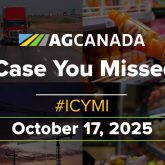Farmers need a radically rebuilt farm safety net and national agricultural policy, regardless of the eventual ending of the COVID-19 crisis, argues a new analysis paper.
The pandemic won’t be the cause of many permanent changes in the world food markets but could worsen negative developments previously underway.
“The breadth and depth of issues impacting the agri-food policy landscape in Canada has perhaps never been more challenging,” say analysts Douglas Hedley, Al Mussell and Ted Bilyea.
Read Also

Feds propose overhaul of chronic wasting disease control program
Chronic Wasting disease control program getting updated by Canadian Food Inspection Agency with feedback encouraged from producers.
“However, beyond the immediate and urgent needs of the COVID-19 crisis, these signal more fundamental shifts and threaten the relative cohesion in Canadian agri-food policy that has occurred over the last 25 years.”
The researchers, with Agri-Food Economic Systems of Guelph, Ont., say in New Pressures for Renewal Demand a New Canadian Agri-Food Policy that most of the underpinnings of Canadian farm and food policy of the past few decades are in danger of breaking.
The threatened foundation of assumptions includes:
- North American and world prices that reflect crop and meat supply, demand and economics;
- A general situation of open markets and rules-based international trade;
- Access to foreign temporary farm workers;
- World agricultural production not significantly distorted by production subsidies.
Canada’s farmers and the industries they support are also threatened by a possible breaking down of the co-operative federal-provincial approach that has been predominant since the early 1990s, the analysts say.
The two sets of risks, from a worsening international trading environment and weakening national co-operation, are tightly connected.
“Provincialism and beggar-thy-neighbour provincial to grow (or) retain provincial industries could result (from being cut off from export markets.) Agri-food is especially vulnerable to provincialism as it is a portfolio of joint federal and provincial authority…. Accommodating (and) facilitating domestic demand for products whose existing capacity has been predicated on extensive and liberal export market access in specific regions could be challenging and disruptive.”
The analysts worry that a permanent worsening of Canada’s agricultural situation might be missed by government authorities focused on surviving the pandemic and not seeing longer-term threats that have been evolving both before and during COVID-19.
“In this new environment, the concern exists that we could greatly underestimate the true nature of perils and risks that apply to the various stages of the agri-food supply chain.
“Our existing expectations of business risks are predicated on our experience of rules-based trade …, and the stable domestic agri-food policy environment since the (safety net) arrangements leading to stable five-year funding agreements. This experience may not be indicative of what is to come.”
The pandemic has been a shock to food systems around the planet, but that should not obscure the swing into protectionism and farmer-subsidization by some of Canada’s chief competitors in the export market.
The U.S., with which Canada has a most intimate economic relationship, has profoundly shifted into an “America-first” approach of protectionism, managed trade, and massive farming subsidies, as well as undermining international institutions such as the World Trade Organization.
China has also lurched hard into power-based trade and away from rules-based behaviour, and other players such as the European Union have continued to use their regulatory systems to manipulate and control trade.
These developments undermine Canada’s farming and export economics, the analysts say. The normal price signals that should encourage U.S. farmers to produce less are obscured by farm subsidies, so those farmers keep producing, further knocking low prices lower, while managing to break even.
Canadian farmers, without similar government support, receive the same U.S.-based prices, but end up losing money or making far less than they would if subsidies were not distorting production in the U.S.
The U.S. has also been able to force U.S. agriculture sales to China, while Canada does not have the same power.
The authors see the risk of interprovincial agricultural trade spats occurring if export-oriented food commodities get redirected toward the domestic Canadian market. It is too small to absorb much, so provincial governments might try to favour in-province production to out-of-province.
The pandemic has exacerbated an existing problem in Canadian fruit and vegetable production with access to foreign temporary workers. If sufficient numbers of foreign workers aren’t available, that industry could collapse and exacerbate the existing reliance upon imported fruits and vegetables.
The paper argued that Canadian farmers probably need greater and broader support from federal and provincial programs if these trends prove permanent.
Present safety nets are well-designed for an era of rules-based free trade in which crop and meat prices are based on long-term costs of production, but they are not sufficient for an era of greater foreign government subsidization of farmers and prices based on chronic overproduction.
Hedley, Mussell and Bilyea are not despairing of the future for Canadian farmers. They see Canada having great advantages in terms of the natural environment for producing crops and livestock.
And they think Canada can capitalize better than most countries upon demands for lower-carbon and sustainable forms of agriculture.
“Canada has the capacity to be a robust agri-food exporter in a world in which this will become more valued over time,” says the report.
However, the structural problems of the new world order need to be addressed.
“… the challenges of the time implore us to think more broadly, deeply and boldly in strategic agri-food policy planning.”
















